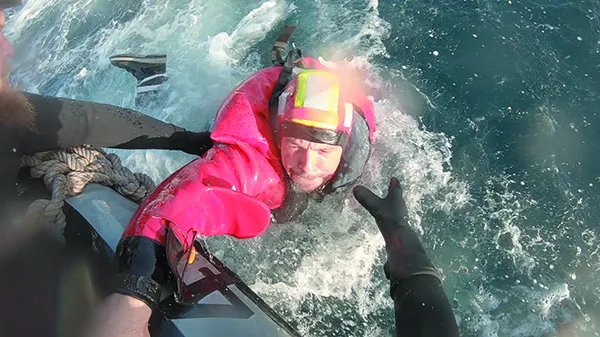
As air temperatures in the northern hemisphere warm enough for sailors to start spending time on the water, boating safety experts are reminding sailors that water temperatures in many bays and estuaries remain quite dangerous for prolonged exposure. “Dress for the water temperatures, not for the air temperatures,” is a motto worth remembering during these early months of spring.
Temperate regions with shallow basins like the Chesapeake Bay area can be particularly deceptive warm during these early days of spring. The 70F (21C) air temperatures expected this weekend can entice us to dress just like we did during our last sail during summer, when the local waters were like a bathtub.
U.S. Coast Guard in Virginia is reminding recreational boaters and paddlers to be mindful of the inherent dangers of cold water temperatures as air temperatures rise in the region. Despite air temperatures increasing to spring-like conditions, the ocean, Chesapeake Bay, rivers, and surrounding lakes in the area remain significantly colder.
Cold water can be particularly dangerous this time of year because warmer air temperatures can encourage people to dress for warmer weather, without realizing the water temperature is drastically different. Even with forecasted highs around 70F (21C) in some parts of the region in the days ahead, the water temperature in the Chesapeake Bay near Cape Henry is only 42F (5C) with other bodies of water displaying similar cold temperatures.
“Dressing for the water temperature, not the air temperature, and wearing a lifejacket are the best ways to increase your chance of survival should you fall in cold water,” said Lt. Mitchell Latta, a Search and Rescue Mission Coordinator at Sector Virginia. “Not only do life jackets keep you afloat, they provide insulation and make you visible to responders. Therefore, having a life jacket on before entering the water is key.”
Roughly 20 percent of people who fall into cold water die within the first minute due to cold-water shock, or the gasp reflex. Even the strongest swimmers lose muscle control after 10 minutes of being exposed to cold water, making it nearly impossible to put on a life jacket and call for help.
Practical Sailor’s archives have a series of articles on cold weather survival, including a comprehensive report on choosing the right clothing for cold weather sailing by Technical Editor Drew Frye, who sails on the Chesapeake all winter long. My previous blog post on this topic “The Chilling Facts About Cold Water Survival,” includes links to the enlightening research of Dr. Gordon Giesbrecht, aka “Professor Popsicle,” who has developed some proven methods for increasing odds of survival.
Boaters and paddlers should also have a VHF-FM marine radio on hand to call for help during an emergency and bring along other safety equipment such as EPIRBS, first aid kits and dewatering equipment. For a full list of safety gear visit https://www.safeboatingcouncil.org/
For more information on how to stay safe on the water, please visit The Coast Guard Auxiliary;s boating safety website at http://wow.uscgaux.info/content.php?unit=B-DEPT or contact your local Coast Guard Auxiliary Unit at https://www.cgaux.org/units.php.


































Those of us who are avid sailors on Puget Sound are fully aware of cold water. It’s also important to inform our guests of this.
Well, I guess its a matter of who you are writing for. If you want your articles to be interesting for ‘everyone else’ maybe you could consider adding the temp scale that the majority of the world uses, deg C.
If not I get it.
Perry, People who are reading these articles surely don’t lose interest just because of different measurement standards. In the USA, we use degrees F; get used to it.
Good catch, Perry. I added Celsius temps. We try as much as possible to address the larger audience, and that means metric measurements — but for the online US-centered news items like this, it often slips through the cracks. We’ve contemplated going full metric to simplify things, perhaps a reader survey is in order.
Thanks for updating this with Celsius